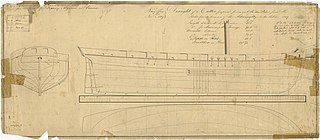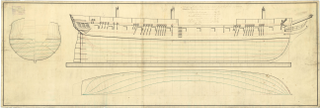
HMS Tonnant was an 80-gun ship of the line of the Royal Navy. She had previously been Tonnant of the French Navy and the lead ship of the Tonnant class. The British captured her in August 1793 during the Siege of Toulon but the French recaptured her when the siege was broken in December. Rear-Admiral Horatio Nelson captured her at Aboukir Bay off the coast of Egypt at the Battle of the Nile on 1 August 1798. She was taken into British service as HMS Tonnant. She went on to fight at the Battle of Trafalgar in 1805, during the Napoleonic Wars.

HMS Aetna was the mercantile Success launched in 1803 at Littlehampton. The Admiralty purchased her in 1803 for conversion into a Royal Navy bomb vessel. Aetna participated in the second Battle of Copenhagen in 1807 and the Battle of the Basque Roads in 1809. Later, she participated in the attack on Fort McHenry in the Battle of Baltimore and the bombardment of Fort Washington, Maryland in 1814, during the War of 1812. The Navy sold her in 1816 and she returned to mercantile service under her original name. She sailed to Calcutta, to Rio de Janeiro, and more locally until she was wrecked in 1823.
HMS Fox was a 32-gun Active-class fifth rate frigate of the Royal Navy. She was launched on 2 June 1780 at Bursledon, Hampshire by George Parsons.

HMS Starr was a 16-gun Merlin-class ship sloop of the Royal Navy. She was built by Tanner, of Dartmouth, to plans by Sir William Rule, and launched in July 1805. As a sloop she served on convoy duty, though she also participated in the invasion of Martinique in early 1809. She was rebuilt as a bomb vessel in May 1812 and renamed Meteor. As Meteor she served in the Baltic and then off the United States, participating in attacks on up the Potomac and on Baltimore and New Orleans. She was sold in October 1816.

HMS Royal Oak was a 74-gun third rate ship of the line of the Royal Navy, launched on 4 March 1809 at Dudman's yard at Deptford Wharf. Her first commanding officer was Captain Pulteney Malcolm.
HMS Bedford was a Royal Navy 74-gun third rate. This ship of the line was launched on 27 October 1775 at Woolwich.
HMS Ramillies was a 74-gun third rate ship of the line of the Royal Navy, launched on 12 July 1785 at Rotherhithe. However, it was not actually commissioned by the Navy until February 1793. Its first Captain was Henry Harvey.

HMS Asia was a 74-gun third-rate ship of the line of the Royal Navy, launched on 2 December 1811 at Frindsbury.

HMS Herald was an 18-gun ship-sloop of the Cormorant class in the Royal Navy, launched in 1806 at Littlehampton. In 1810 she was reclassed as a 20-gun sixth rate ship, and again re-rated as 24 guns in 1817, just before she was broken up.
HMS Cydnus was one of eight Royal Navy 38-gun Cydnus-class fifth-rates. This frigate was built in 1813 at Blackwall Yard, London, and broken up in 1816.

The Battle of Lake Borgne was a coastal engagement between the Royal Navy and the U.S. Navy in the American South theatre of the War of 1812. It occurred on December 14, 1814 on Lake Borgne. The British victory allowed them to disembark their troops unhindered nine days later and to launch an offensive upon New Orleans on land.

HMS Borer was a 14-gun Bold-class gun-brig built by Tyson & Blake at Bursledon. She was launched in 1812 and sold off in 1815.

The French frigate Trave was a Pallas-class frigate of the French Navy, launched at Amsterdam in 1812. After the Royal Navy captured her in 1813 in the North Sea, it took her into service as the troopship HMS Trave. She served in the Potomac and her boats participated in the Battle of Lake Borgne during the War of 1812. She was sold on 7 June 1821.

HMS Thistle was a 12-gun Bold-class gun-brig built by Mary Ross at Rochester, Kent. She was launched in 1812 and broken up at Portsmouth in July 1823.

HMS Pigmy was a Pigmy-class 10-gun schooner of the Royal Navy. She was launched in February 1810. She served on the North Sea and North American stations before she was sold in 1823.

HMS Bucephalus was a 32-gun frigate launched at Portsmouth on 3 November 1808. Bucephalus was present during the Invasion of Java. She was later reduced to 18-guns and converted into a troopship at Woolwich Dockyard in 1814. She was part of a squadron that carried the advance guard of Major General Keane's army, which was moving to attack New Orleans, part of the Gulf Campaign. Under the rules of prize-money, the troopship Bucephalus shared in the proceeds of the capture of the American vessels in the Battle of Lake Borgne on 14 December 1814.
HMS Nymphe was a 38-gun fifth rate frigate of the Royal Navy, launched on 13 April 1812 at Woolwich Dockyard, and commissioned later that month. She was a Lively class of 18-pounder frigates, designed by the Surveyor of the Navy, Sir William Rule. It was probably the most successful British frigate design of the Napoleonic Wars, to which fifteen more sister ships would be ordered between 1803 and 1812.

HMS Dover was a 38-gun troopship, previously the French corvette Bellona, launched at Venice in 1808. She was captured at Lissa in 1811. She served as a troopship and transport until circa 1819. She then became the flagship for the Admiral commanding the Leith station. She was used for harbour service from 1825, and was sold in 1836.
HMS Thames was a 32-gun fifth-rate Thames-class frigate of the Royal Navy, launched in 1805 at Chatham.
HMS Diomede was a 50-gun fourth-rate ship of the line of the Diomede class of the Royal Navy. She was launched in 1798.












